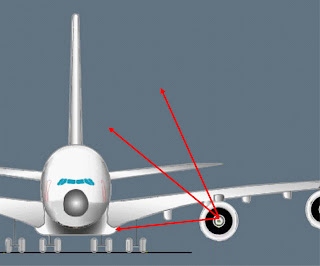A380 operators with Rolls Royce engines feeling like clowns in the circus
Published by Julia Volkovah under air safety, aviation, Travel on 10:41 PM There's a treasure trove of fascinating facts in the preliminary report issued by the Australian Transport Safety Bureau Friday morning and I promise I'll get to all of it. But not in one blog, there's just too much here.
There's a treasure trove of fascinating facts in the preliminary report issued by the Australian Transport Safety Bureau Friday morning and I promise I'll get to all of it. But not in one blog, there's just too much here.Today let me just address the news. The ATSB has issued another safety recommendation and Qantas has let’s see, one, two…now! to comply.
After discovering what might be a manufacturing flaw in an oil feeder pipe in the engine that went bust on Qantas Flight 32 November 4, the folks at the ATSB and Rolls Royce are thinking perhaps a misalignment might have caused thinning in one wall of the pipe - leading to fatigue, leading to cracks, leading to oil leaks, leading to the engine fire, leading to the unfortunate and highly dramatic failure of the A380 ’s number 2 engine.
’s number 2 engine.
 |
| All photographs courtesy of ATSB |
To the right, is the photo the ATSB released to illustrate the damage. Frankly, I’m not enough of a gear head to see it exactly. Is thinned metal in a tube really photograph-able? I’m not so sure. ATSB Chief Commissioner, Martin Dolan told reporters this morning the inspection is highly specialized, involving borescopes and stuff. So the Civil Aviation Safety Authority has directed Qantas to look for any “abnormal or eccentric counter-boring of the tubes” within two flight cycles, in other words right away. If this manufacturing defect is anything more than a one-off, inspections by Qantas Lufthansa and Singapore, the other two airlines flying with Trent 900s on their A380s, it should show up pretty quick.
The engines are also going to get a software update, a little high-tech Mr. No so that if an engine starts to over speed, which is preliminary to its busting out the sides of its housing, the electronics that are so crucial to aviation in the 21st century will put a quick halt to that by shutting down the engine.
And just in case you want further illustration of why runaway engines need to be held in check, take a look at this graphic from the same ATSB report showing the trajectory of Flight 32’s bad boy when its engine parts were “liberated” - flying through the engine cowling and causing plenty of thumps, hisses and OMGs among the 469 people on board.
Is this not a picture worth a couple of hundred words? Holy s… being the first two? What do you think the passengers with seats on the upper deck left side are thinking today?
While a lot of ground has been covered by investigators so far, I suspect round about now, the three airlines flying Trent 900 engines, may feel a little bit like circus clowns ad libbing their way through each new day and wondering when the next cream pie will smack them in the face.
